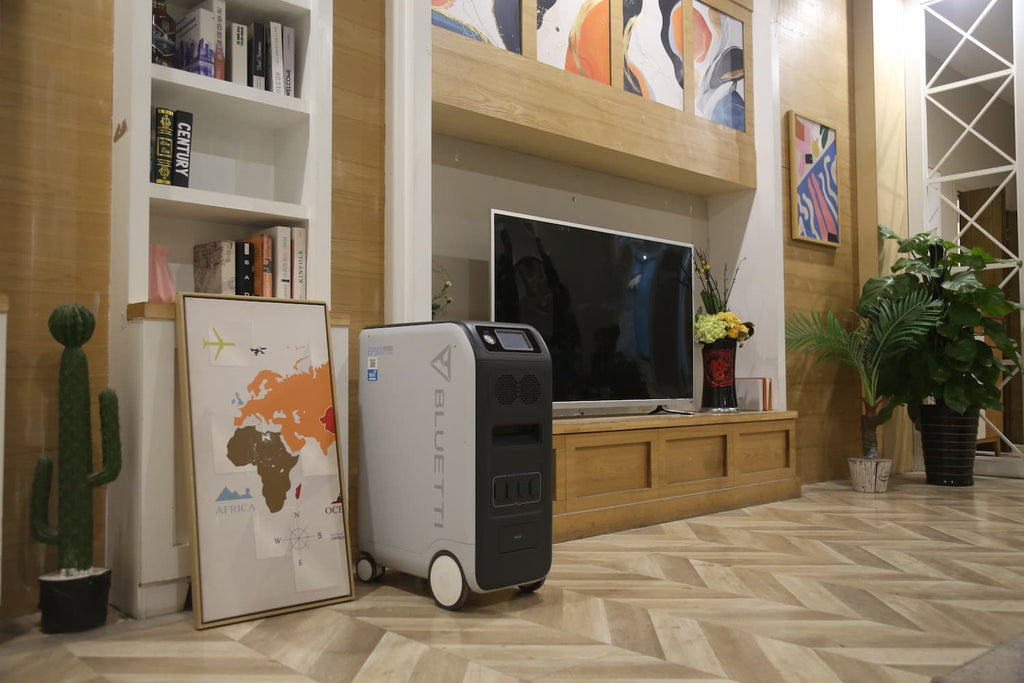Your cart is empty
Shop our productsFans are our all-time companions in summer. Life without them is simply unthinkable. Yet, the electrical bills in summer are not to be taken lightly. This brings to light the question: how much electricity does a fan use?
Let us explore the portion consumed by fans in our dreaded electricity bills, the factors leading to a higher bill, and potential solutions to reduce our electricity bills.
Understanding the Basics
Before proceeding to learn how much electricity does a fan use, let us first understand the basic electrical terms that you will encounter in this endeavor.
Watts
When fans are running, they run on electricity. This power that they draw while running is given in watts. Therefore, watts is the unit that tells you how much power a fan utilizes while running.
For example, suppose your fan has a 50-watt power consumption. This means that your fan will use 50 watts of electricity every hour while running.
Amp Hours
Another electrical term is amp hour. Amp hour is the measure of the total amount of electricity a battery-powered fan can store and deliver. In other words, amp hours denote how long a fan can run depending on its battery.
For instance, suppose your fan has a 5,000mAh battery. This means that, theoretically, it can run for 10 hours at 500mA (milliamps).
Factors Affecting Fan Electricity Usage

There are several factors at play that we need to keep in mind when estimating how much electricity does a fan use.
1. Fan Type
There are various types of fans available on the market. From ceiling fans to tower fans to desk fans, each type has its own perks and usage. Similarly, the wattage range of each type varies.
Since how much electricity does a fan use is different for each of these types, it is necessary to know which type of fan you have to determine its electrical consumption. Only after understanding it can you implement strategies to reduce your electrical bills.
2. Fan Size
As with everything else, size makes a world of difference. A relatively smaller size would not have as great a wattage as its relatively bigger brethren. Accordingly, how much electricity does a fan use is not as great as a bigger fan.
Conversely, a relatively bigger fan has a higher wattage than its smaller counterpart. As such, how much electricity does a fan use is higher.
3. Fan Settings
You must have seen several settings on your fans, namely the low, medium, and high ones. Ever wondered how much electricity does a fan use depending on which of these three settings you apply?
Well, it might be cliche, but yes, a high setting consumes more electricity than a medium one; a medium setting eats up more electricity than a low one. So, if you do not require a high setting, better opt for a medium or low one, depending on which best suits your needs.
4. Energy Efficiency Rating
When choosing fans for your home, you will do yourself a huge favor by opting for one with an energy-efficient rating. Just like its name suggests, an energy-efficient rating promises optimum cooling without consuming too much electricity.
Therefore, you will never regret choosing a fan with this rating. It does not add to your electrical bill as a fan without the energy-efficient rating would. Tempting, isn’t it?
How Much Electricity Does a Fan Use

Use the following method to calculate how much electricity does a fan use.
1. Find the Wattage of Your Fan
First things first, you need to find the wattage of your fan. You will need to find a label on the fan - that label will have the wattage of your fan listed on it. Alternatively, you can also see the wattage in the user manual.
If you cannot find the wattage anywhere, you can calculate it using the formula of wattage.
The formula is: Wattage (W) = Volts (V) * Amps (A)
Example:
Let Volts = 120V
Let Amps = 1.5A
Wattage = Volts * Amps
= 120 * 1.5
= 180W
2. Estimate Your Daily Usage
The next thing in your endeavor to calculate how much electricity does a fan use is to estimate your daily fan usage. Do you generally run it for 5 hours a day, or is it 10 hours a day?
You do not have to have an exact figure of hours and minutes. You only require a general estimation of how many hours your fan runs daily on average.
3. Calculate Daily Energy Consumption
Now that we have the relevant data, time to proceed to the actual calculation to, ultimately, find out how much electricity does a fan use. The formula to calculate this energy consumption is:
Energy Consumption (kWh) = Wattage (W) * Hours Used per Day / 1,000
Example:
Let Wattage = 180W
Let Hours Used Per Day: 10 hrs
Energy Consumption = Wattage * Hours Used per Day / 1,000
= 180 * 10 / 1,000
= 1,800 / 1,000
= 1.8 kWh
4. Calculate Monthly Energy Consumption
Moving forward, now we will calculate the monthly energy consumption. The formula for this is:
Monthly Energy Consumption (kWh/month) = Daily Energy Consumption (kWh/day) * 30
Example:
Let Daily Energy Consumption = 1.8 kWh
Monthly Energy Consumption = Daily Energy Consumption * 30
= 1.8 * 30
= 54 kWh/month
5. Estimate Cost
Now, on to the final step in determining how much electricity does a fan use. Time to calculate the cost a fan adds to your monthly electricity bill. The formula is:
Cost = Monthly Energy Consumption (kWh/month) * Average Electricity Rate of Your Area
Example:
Let Monthly Energy Consumption = 54 kWh/month
Let the Average Electricity Rate of Your Area = 16.21 cents per kilowatt-hour
Cost = Monthly Energy Consumption * Average Electricity Rate of Your Area
= 54 * 16.21
= 875.34 cents/month
Types of Fans and Their Wattage Range
As mentioned above, how much electricity does a fan use depends on the type of fan you have. So, let us now explore each type of fan’s average electrical usage.
1. Ceiling Fans
You will find ceiling fans literally everywhere, especially in homes. These all-time companions have a wattage as low as 50W, and the figure can go as high as 150W, depending on their size and setting.
2. Tower Fans
Tower fans offer you focused blasts of cool air, effectively cooling the entire room. Their wattage can range from as low as 45W to as high as 60W, depending on their size and setting
3. Desk Fans
Desk fans are the all-time favorites for those who require adequate cooling in a limited space. Their wattage can be as low as 30W and can go as high as 60W, depending on their size and setting.
|
Types of Fans |
Their Wattage Range |
|
Ceiling Fans |
50W to 150W |
|
Tower Fans |
45W to 60W |
|
Desk Fans |
30W to 60W |
BLUETTI Products to Save Energy
Now that we have an understanding of how much electricity does a fan use, and what factors affect it, time to move on to power-saving solutions.
Opting for solar products is an undeniably effective method of saving your electrical costs. In this regard, BLUETTI’s solar products will offer you exactly what you are looking for.
1. BLUETTI EP500 Solar Power Station

The BLUETTI EP500 Solar Power Station is a high-capacity, durable power solution, ideal for a range of applications, including home backup, off-grid power needs, and outdoor activities.
Key Features:
Capacity: It has a 5,120Wh capacity, meaning it can store a substantial amount of energy equivalent to 5,120Wh.
Battery Life: Boasting a LiFePO4 battery and over 3,500 cycles to 80% capacity, you are guaranteed long-term durability and reliability.
Power Output: It has a 2,000W Pure Sine Wave Output. With this vast power output, you can easily power up various electronic devices, including your fan.
UPS Modes: It has two UPS modes - In-grid UPS Mode and Flexible UPS Mode. They make this system a great power backup solution in off-grid scenarios or for constant backup needs.
2. BLUETTI AC300 + 2*B300 Home Battery Backup

The BLUETTI AC300 + 2*B300 Home Battery Backup is another remarkable home power backup system. You will love its powerful inverter, capacity, split-phase system, and UPS.
Key Features:
Inverter Output: It boasts a 3,000W AC Pure Sine Wave Inverter, providing you with a clean and stable source of power for your fans and other electrical appliances.
Capacity: It has a capacity of 6,144Wh, thus promising you a sizable amount of stored energy for your fans and other electrical devices.
240V Split Phase Bonding: You can create a 240V connection using two AC300 units and two B300 batteries.
UPS: This system provides you with a 24/7 UPS Home Backup, promising you continuous power availability. How cool is that!
Speaking of UPS, find out the BLUETTI new UPS solar batteries of 2024
Final Words
Now that you have an idea of how much electricity does a fan use, and what factors affect it, it is time to take action to reduce your electricity bills. Go solar!
Moreover, when considering solar products, the BLUETTI EP500 Solar Power Station and BLUETTI AC300 + 2*B300 Home Battery Backup are great devices to opt for.
Shop products from this article
Be the First to Know
You May Also Like

What Does a 30% Federal Solar Tax Credit Mean and How to Apply?
Governments around the world are offering programs that encourage homeowners to switch to solar energy. Among the most notable programs is the 30% Federal Solar Tax Credit. It reduces your...

Deadly Flooding Devastates U.S. South and Midwest — What You Need to Know

















































































































































































































































